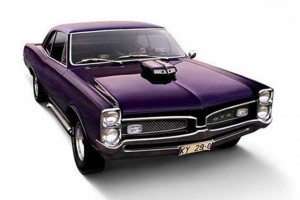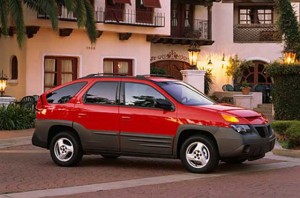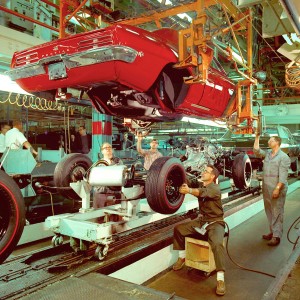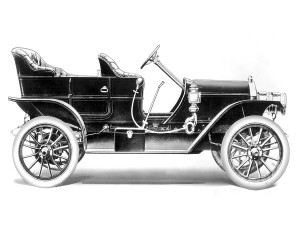
The original Pontiac GTO gave the GM claim to its long-running ad tag line, "We Build Excitement." But there hasn't been much excitement in recent years.
It seemed like the proverbial no-brainer when General Motors announced plans, early in the decade, to revive its legendary muscle car, the Pontiac GTO. After all, few automobiles had become so entrenched in American lore, inspiring songs, like Ronnie and the Daytona’s “Little GTO,” and countless appearances in film, TV and other corners of popular culture.
First launched in 1964, the “Goat,” as its fans liked to call it, was arguably the first true American muscle car, derived fromthe expediant and wildly profitable formula of stuffing a full-size V8 engine in a mid-size car and charging a premium for it.
The creation of General Motors’ mad genius, John DeLorean, the GTO dominated road and track until it was summarily abandoned in the wake of the first Mideast oil crisis. But with muscle making a comeback, GM’s new “car czar,” Bob Lutz, was convinced the muscle car could reverse the fading fortunes of the flailing Pontiac.
 But the return of the Goat proved to be just the latest in a long series of setbacks for the once-popular brand. Potential Pontiac buyers did little more than yawn over the blandly-styled 2004 GTO and despite a series of frantic efforts to prop up the retro nameplate, disastrous sales forced the automaker to once again pull the plug less than three years later.
But the return of the Goat proved to be just the latest in a long series of setbacks for the once-popular brand. Potential Pontiac buyers did little more than yawn over the blandly-styled 2004 GTO and despite a series of frantic efforts to prop up the retro nameplate, disastrous sales forced the automaker to once again pull the plug less than three years later.
Now, it seems, GM is ready to toss Pontiac itself onto the automotive rust heap. On Monday, the ailing automaker unveiled its latest turnaround plan, this one triggered by President Barack Obama’s refusal to authorize a second round of federal aid for GM until it came up with a more acceptable business strategy. The plan the president rejected would have jettisoned Hummer, Saturn and Saab, but maintained Pontiac as a low-volume niche brand, paired with Buick and GMC.

"We build...", um, er, uh... camels? The Aztek may have sealed the fate of GM's Pontiac division, which many critics would have killed off years ago.
“We didn’t think we had the resources to get this done from a product perspective,” or with the necessary marketing resources, said GM CEO Fritz Henderson, when asked why the company was walking away from what was once known as “the Excitement Division.”
The reality is that the excitement has long been gone. And virtually nothing GM has tried, in recent decades, has been able to bring the energy back.
The Pontiac name first appeared in 1926, though it was originally just one of the nameplates belonging to another long-gone General Motors brand, the Oakland Motor Car Division. Named for the legendary Michigan Indian chief, the first Pontiac model was conceived as an affordable six-cylinder alternative to the less-powerful four-cylinder models of the day. When it added an equally affordable straight-eight, in the early 1930s, Pontiac surged on the sales charts, becoming one of the most popular models in the country.
In 1932, GM’s renowned Chairman Alfred P. Sloan decided to dump Oakland and focus on Pontiac as part of his strategy to offer Americans “a product for every purse and purpose.”
While the division introduced a variety of innovations, during the decades to come, it wasn’t until the mid-1950s that Pontiac began its rise among GM brands. Led by General Manager Semon “Bunkie” Knudsen, and engineering directors Elliot “Pete” Estes and DeLorean, Pontiac began a dramatic remake as a mid-market, rather than base, brand focused on “wide track” performance. In a striking move, Motor Trend magazine named the division’s entire line-up its “Car of the Year” for 1959.
But tail fins weren’t what would transform the word, Pontiac, into a household name. That came with the launch of the original GTO. Short for “Gran Turismo Omologato,” – in Italian, “Grand Touring, Homologated” – the name was intended to provide instant racing bona fides. But what really mattered was what happened where the rubber met the road. And many of the division’s senior executives – including DeLorean himself, would often take out GTO prototypes, late at night, drag racing on Detroit’s main thoroughfare, Woodward Ave.

Firebird and Trans Am were Pontiac's answer to Ford's fabulously successful Mustang.
While the Goat fell victim to the energy crisis, Pontiac continues to push performance, introducing models like the Firebird and its top-line spin-off, the Trans Am. But in a new world where mileage, safety and refinement mattered, Pontiac lost its traction. Each successive model grew more heavy and bloated and by the time the ‘bird and Trans Am were yanked, in 2002, one-time aficionados barely noticed.
Pontiac’s other offerings weren’t doing much better. Mainstream models, like the Grand Am, Grand Prix and Bonneville, were pale competitors to the latest from Japan and Europe, and the division continued to decline. Eventually, Pontiac dropped its tagline, “We Build Excitement,” realizing it had become little more than a hollow joke upon itself.
If anything, Pontiac had, by the ’90s, become the prime example of everything wrong with General Motors. Its sedans were often indistinguishable from similar products offered by other GM brands. Worse, efforts to create real breakthroughs either failed or left Pontiac open to ridicule.
For years, Pontiac executives kept promising to introduce flexible offerings that would, in the words of former division manager John Middlebrook, “be as functional as a Swiss Army knife.” Eventually, it came up with the Aztek.
On paper, it was a brilliant concept, with countless nooks and crannies to serve as storage and even a bolt-on camper system, as well as a pull-out cargo bed. In practice, internal fighting between design, marketing and manufacturing created the automotive equivalent of a camel. It did its job, but it left buyers scratching their heads or walking away in disgust. Sales never rose to more than a fraction of expectations, underscoring Pontiac’s continuing decline. A public relations program that made defiant lemonade out of the lemon – Kiss My Aztec – never got off the ground.
There have been a few bright spots. The Pontiac Solstice was Detroit’s first affordable roadster in years, but despite an attractive price tag, it still suffered from design and mechanical problems that never let it gain on offshore competitors, like the Mazda Miata.

The beginning and now the end...
And so, with GM’s overall sales and share plunging, and it becoming all but impossible to sustain so many divisional mouths, many analysts began asking just how much of a future Pontiac had. When the weakening giant conceded to reality and pulled the plug on Oldsmobile, it seemed like little more than a matter of time before other divisions would follow. Initially, Buick seemed the likely candidate, but that brand proved unexpectedly popular in China, now the world’s largest auto market, so eyes turned to other marques.
The idea of using Pontiac as the badge of choice for specialty models, like Solstice, was the last possible resort, it turned out, but one that simply didn’t make economic sense in the Great Recession.

Paul,
Your story was a wonderful tribute to what was one of the stars which occasionally burned bright in the GM sky. In the end, it will not be Obama who killed Pontiac. I am afraid it will turn out to be my honest, hard working, car loving, 88 year old father who put the final nail in their coffin.
My dad has always loved cars and never missed an opportunity to buy one which struck his fancy. Let me share a list of the interesting rides he had: 37 Essex, 51 Hudson Hornet, 54 Packard Clipper, 63 Studebaker GT Hawk, 71 Plymouth Road Runner, and just last year, a 07 Pontiac G5.
Sure, this is a slightly edited list. I did not mention that he had a 57 Chrysler Saratoga and a 65 Imperial. While he did kill both models, Chrysler itself proved much more resiliant than I would have thought. Did I mention he had a 61 Alfa Romeo 2000 Roadser? That company has had more lives than a vampire.
Dad also had several Volvos while I worked there as PR Manager and later as Director of Marketing. I seriously considered paying him to buy something other than a Volvo. It seemed like it might be a good career move. Well, even a half dozen exposures to my father’s company killing karma could not bring Volvo to its knees. Just as I told people for all of those years Volvos really are safe, strong, and built to last.
If any other car company employees are reading this blog, I would like to make them an offer. For the right price, I will see to it that my dad never buys one of your cars! Based on statistical evidence, this may be an offer you should not refuse.
Good article.
A sad day for my generation. I know it had to happen but it’s still depressing.